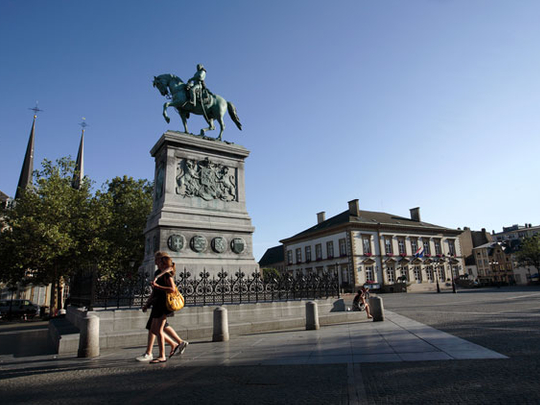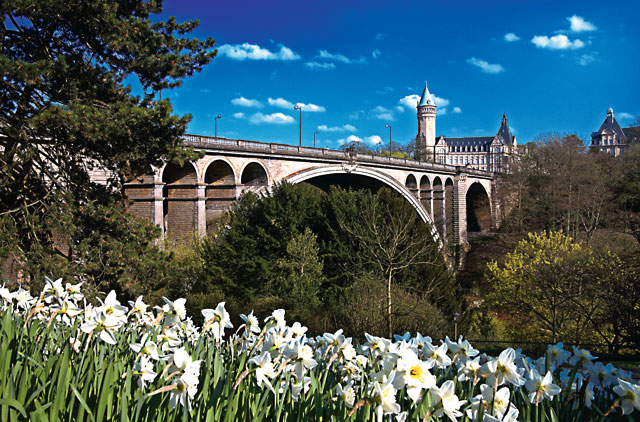
It is the mix of different cultures that makes Luxembourg worth a visit. The small country’s heritage dates back to Roman times, when it was a fortress site, to the Middle Ages, when Luxembourg hosted a Frankish count’s castle, and was an important hub in Europe for the Spanish emperors in the 16th and 17th century. Today, the smallest member of the European Union is home to fairytale castles, romantic ruins, interesting museums and classy vineyards, along with glitzy shopping arcades and Michelin-star French restaurants.
Luxembourg is a trilingual country, where German, French and Luxemburgish are the official languages, but due to a mix of nationalities, English is also widely spoken.
Travelling to Luxembourg is quite easy. The country has an efficient road, rail and air transport system, is linked to Paris with the high-speed train TGV and served by major airlines such as Lufthansa, British Airways, KLM, Swiss, Scandinavian, Air France, and a couple of regional carriers.
There is no shortage of accommodation in the Grand Duchy. Check in at the Le Place d’Armes, Luxembourg’s best luxury hotel, at a perfect location in the city centre — only 300 metres from the Notre Dame cathedral and within walking distance of the Grand Ducal Palace and the restaurant quarter Ilôt Gastronomique.
The boutique hotel boasts an art-deco style and can be recommended for the discerning traveller. Other options to spend a comfortable night in Luxembourg include the Hotel Royale, the Double Tree Hilton or the Sofitel Le Grand Ducal.
Day 1
Take a walk across the Old Town in the morning:
On the first day in Luxembourg the way leads across the Old Town, through narrow lanes filled with historic architecture. Join one of the guided town walks that start from the Grand Ducal Palace and that takes about two to three hours. The walks show the most beautiful sights of the city centre and the picturesque Old Town. The palace is the official residence of the Grand Duke of Luxembourg and dates back to the 16th century. Nearby, you will see the neo-Gothic cathedral of Notre Dame, with its famous casemates, fortifications and underground defences, all built in the 17th century; some of its tunnels date back to as early as the eighth century. Further on, stroll across Place Guillaume II, the city’s central square with the impressive City Hall in the southwest. Move on to reach the Gelle Fra memorial (luxemburgish for “Golden Lady”), an obelisk dedicated to the Luxembourgers who served in the First World War. Behind the memorial, walk across Adolphe Bridge, a famous arch bridge and one of the city’s main tourist attractions, and take pictures of the city. For lunch, walk back to the Place d’Armes, a square in the city centre where you can find numerous restaurants and cafés.
Afternoon schedule: Museum visits
In the afternoon, it’s time for museums. There are two particularly interesting museums in the Old Town, the Luxembourg City History Museum, which traces the history and heritage of the city from its founding to present times, and the National Museum of History and Art, which offers insights into Celtic and Roman artefacts, findings and artworks.
Another must-visit is The National Museum of Military History, where visitors get the big picture on the Battle of the Bulge, or the Ardennes Offensive, launched by the Germans at the end of the Second World War.
After that, pay a visit to the Natural History Museum at the Grund quarter if you are interested in fossils and the scientific history of the region. Otherwise, visit the Neumünster Abbey, a former monastery that today serves as a public meeting place and cultural centre.
Evening time: Get lost at the Grund
As you are already in the Grund valley, experience the vibrant night life. Once a poor quarter of the city, the Grund has become increasingly popular for its beverage outlets in the narrow medieval streets and for its restaurants. You will find a cuisine that is a blend of French finesse and German heartiness. Local dishes include ‘Friture de la Moselle’ (small deep-fried river fish), ‘Pike in Riesling Sauce’ and ‘Wild Boar’ among other sumptuous specialties. Don’t forget to order a side of sausage and sauerkraut. Top it off with a cup of Luxembourg’s fine coffee and a slice of cake.
We recommend either the Restaurant Bosso, or the Bick Stuff, the Mosconi or the Chez Bacano, all in the Grund quarter. Later on, you have a wide choice of different night clubs. Try The Tube for a spot of fun and dance.
Day 2
European Union sightseeing in the morning:
The next day, it is time for some modern sightseeing. Take a cab up to the Kirchberg Plateau between the city and the airport, and you are in the business centre and in Luxembourg’s European Union quarter, with institutions such as the European Investment Bank. Visit the impressive Museum of Modern Art and the Philharmonic concert hall. Have lunch in one of the numerous Kirchberg restaurants.
Take a pleasure trip in the afternoon:
Luxembourg’s tourist office in the city centre and many travel agencies offer half-day round trips to the countryside, through which you can visit the picturesque town of Vianden near the German border, or Echternach, Luxembourg’s oldest town, founded in AD698. Wine enthusiasts will certainly not object to a trip to the Moselle Valley with its rounded hills lined by vineyards. At the end of the trip, stop at Les Thermes, a water park just west of Luxembourg City, and relax in wave baths and in the sauna.
Evening dinner
Round up your trip to this stunning place with a farewell dinner in one of Luxembourg City’s Michelin-star restaurants, Clairefontaine, or Le Bouquet Garni.









